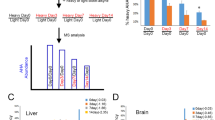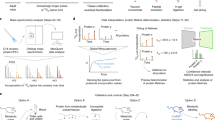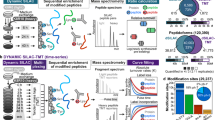Abstract
Protein turnover is an effective way of maintaining a functional proteome, as old and potentially damaged polypeptides are destroyed and replaced by newly synthesized copies. An increasing number of intracellular proteins, however, have been identified that evade this turnover process and instead are maintained over a cell's lifetime. This diverse group of long-lived proteins might be particularly prone to accumulation of damage and thus have a crucial role in the functional deterioration of key regulatory processes during ageing.
This is a preview of subscription content, access via your institution
Access options
Subscribe to this journal
Receive 12 print issues and online access
$189.00 per year
only $15.75 per issue
Buy this article
- Purchase on Springer Link
- Instant access to full article PDF
Prices may be subject to local taxes which are calculated during checkout



Similar content being viewed by others
References
Steinkraus, K. A., Kaeberlein, M. & Kennedy, B. K. Replicative aging in yeast: the means to the end. Annu. Rev. Cell Dev. Biol. 24, 29–54 (2008).
Taylor, R. C. & Dillin, A. Aging as an event of proteostasis collapse. Cold Spring Harb. Perspect. Biol. 3, a004440 (2011).
D'Angelo, M. A., Raices, M., Panowski, S. H. & Hetzer, M. W. Age-dependent deterioration of nuclear pore complexes causes a loss of nuclear integrity in postmitotic cells. Cell 136, 284–295 (2009).
Savas, J. N. et al. Extremely long-lived nuclear pore proteins in the rat brain. Science 335, 942 (2012).
Belle, A., Tanay, A., Bitincka, L., Shamir, R. & O'Shea, E. K. Quantification of protein half-lives in the budding yeast proteome. Proc. Natl Acad. Sci. USA 103, 13004–13009 (2006).
Cambridge, S. B. et al. Systems-wide proteomic analysis in mammalian cells reveals conserved, functional protein turnover. J. Proteome Res. 10, 5275–5284 (2011).
Yen, H. C., Xu, Q., Chou, D. M., Zhao, Z. & Elledge, S. J. Global protein stability profiling in mammalian cells. Science 322, 918–923 (2008).
Price, J. C., Guan, S., Burlingame, A., Prusiner, S. B. & Ghaemmaghami, S. Analysis of proteome dynamics in the mouse brain. Proc. Natl Acad. Sci. USA 107, 14508–14513 (2010).
Piha, R. S., Cuenod, M. & Waelsch, H. Metabolism of histones of brain and liver. J. Biol. Chem. 241, 2397–2404 (1966).
Fischer, C. A. & Morell, P. Turnover of proteins in myelin and myelin-like material of mouse brain. Brain Res. 74, 51–65 (1974).
Rodriguez de Lores, A., Alberici de Canal, M. & De Robertis, E. Turnover of proteins in subcellular fractions of rat cerebral cortex. Brain Res. 31, 179–184 (1971).
Verzijl, N. et al. Effect of collagen turnover on the accumulation of advanced glycation end products. J. Biol. Chem. 275, 39027–39031 (2000).
Sell, D. R. & Monnier, V. M. Aging of long-lived proteins: extracellular matrix (collagens, elastins, proteoglycans) and lens crystallins. in Comprehensive Physiology 235–305 (John Wiley & Sons, 2011).
Shapiro, S. D., Endicott, S. K., Province, M. A., Pierce, J. A. & Campbell, E. J. Marked longevity of human lung parenchymal elastic fibers deduced from prevalence of D-aspartate and nuclear weapons-related radiocarbon. J. Clin. Invest. 87, 1828–1834 (1991).
Masters, P. M., Bada, J. L. & Zigler, J. S. Jr. Aspartic acid racemisation in the human lens during ageing and in cataract formation. Nature 268, 71–73 (1977).
Helfman, P. M. & Bada, J. L. Aspartic acid racemization in tooth enamel from living humans. Proc. Natl Acad. Sci. USA 72, 2891–2894 (1975).
Helfman, P. M. & Bada, J. L. Aspartic acid racemisation in dentine as a measure of ageing. Nature 262, 279–281 (1976).
Tachibana-Konwalski, K. et al. Rec8-containing cohesin maintains bivalents without turnover during the growing phase of mouse oocytes. Genes Dev. 24, 2505–2516 (2010).
McClatchy, D. B., Dong, M. Q., Wu, C. C., Venable, J. D. & Yates, J. R. 15N metabolic labeling of mammalian tissue with slow protein turnover. J. Proteome Res. 6, 2005–2010 (2007).
Bloemendal, H. The vertebrate eye lens. Science 197, 127–138 (1977).
Graw, J. Genetics of crystallins: cataract and beyond. Exp. Eye Res. 88, 173–189 (2009).
Wride, M. A. Lens fibre cell differentiation and organelle loss: many paths lead to clarity. Phil. Trans. R. Soc. B 366, 1219–1233 (2011).
Bassnett, S. Lens organelle degradation. Exp. Eye Res. 74, 1–6 (2002).
Bassnett, S., Shi, Y. & Vrensen, G. F. Biological glass: structural determinants of eye lens transparency. Phil. Trans. R. Soc. B 366, 1250–1264 (2011).
Horwitz, J. α-crystallin can function as a molecular chaperone. Proc. Natl Acad. Sci. USA 89, 10449–10453 (1992).
Rao, P. V., Huang, Q. L., Horwitz, J. & Zigler, J. S. Jr. Evidence that α-crystallin prevents non-specific protein aggregation in the intact eye lens. Biochim. Biophys. Acta 1245, 439–447 (1995).
Xi, J. H. et al. Mechanism of small heat shock protein function in vivo: a knock-in mouse model demonstrates that the R49C mutation in αA-crystallin enhances protein insolubility and cell death. J. Biol. Chem. 283, 5801–5814 (2008).
Giblin, F. J. Glutathione: a vital lens antioxidant. J. Ocul. Pharmacol. Ther. 16, 121–135 (2000).
Lou, M. F. Redox regulation in the lens. Prog. Retin. Eye Res. 22, 657–682 (2003).
Xing, K. Y. & Lou, M. F. Effect of age on the thioltransferase (glutaredoxin) and thioredoxin systems in the human lens. Invest. Ophthalmol. Vis. Sci. 51, 6598–6604 (2010).
Sharma, K. K. & Ortwerth, B. J. Effect of cross-linking on the chaperone-like function of α-crystallin. Exp. Eye Res. 61, 413–421 (1995).
Gupta, R. & Srivastava, O. P. Deamidation affects structural and functional properties of human αA-crystallin and its oligomerization with αB-crystallin. J. Biol. Chem. 279, 44258–44269 (2004).
Harding, J. J. Free and protein-bound glutathione in normal and cataractous human lenses. Biochem. J. 117, 957–960 (1970).
Sharma, K. K. & Santhoshkumar, P. Lens aging: effects of crystallins. Biochim. Biophys. Acta 1790, 1095–1108 (2009).
Hanson, S. R., Hasan, A., Smith, D. L. & Smith, J. B. The major in vivo modifications of the human water-insoluble lens crystallins are disulfide bonds, deamidation, methionine oxidation and backbone cleavage. Exp. Eye Res. 71, 195–207 (2000).
Ortwerth, B. J. & Olesen, P. R. Studies on the solubilization of the water-insoluble fraction from human lens and cataract. Exp. Eye Res. 55, 777–783 (1992).
Ahmed, N. et al. Methylglyoxal-derived hydroimidazolone advanced glycation end-products of human lens proteins. Invest. Ophthalmol. Vis. Sci. 44, 5287–5292 (2003).
Takemoto, L. J. Quantitation of asparagine-101 deamidation from αA crystallin during aging of the human lens. Curr. Eye Res. 17, 247–250 (1998).
Wilmarth, P. A. et al. Age-related changes in human crystallins determined from comparative analysis of post-translational modifications in young and aged lens: does deamidation contribute to crystallin insolubility? J. Proteome Res. 5, 2554–2566 (2006).
Bloemendal, H. et al. Ageing and vision: structure, stability and function of lens crystallins. Prog. Biophys. Mol. Biol. 86, 407–485 (2004).
Roy, D. & Spector, A. Absence of low-molecular-weight α-crystallin in nuclear region of old human lenses. Proc. Natl Acad. Sci. USA 73, 3484–3487 (1976).
Kerrigan, J. J., Mansell, J. P. & Sandy, J. R. Matrix turnover. J. Orthod. 27, 227–233 (2000).
Braverman, I. M. & Fonferko, E. Studies in cutaneous aging: I. The elastic fiber network. J. Invest. Dermatol. 78, 434–443 (1982).
Kragstrup, T. W., Kjaer, M. & Mackey, A. L. Structural, biochemical, cellular, and functional changes in skeletal muscle extracellular matrix with aging. Scand. J. Med. Sci. Sports 21, 749–757 (2011).
Sell, D. R. & Monnier, V. M. Molecular basis of arterial stiffening: role of glycation — a mini-review. Gerontology 58, 227–237 (2012).
Fonck, E. et al. Effect of aging on elastin functionality in human cerebral arteries. Stroke 40, 2552–2556 (2009).
Gosselin, L. E., Adams, C., Cotter, T. A., McCormick, R. J. & Thomas, D. P. Effect of exercise training on passive stiffness in locomotor skeletal muscle: role of extracellular matrix. J. Appl. Physiol. 85, 1011–1016 (1998).
Haus, J. M., Carrithers, J. A., Trappe, S. W. & Trappe, T. A. Collagen, cross-linking, and advanced glycation end products in aging human skeletal muscle. J. Appl. Physiol. 103, 2068–2076 (2007).
Hoelz, A., Debler, E. W. & Blobel, G. The structure of the nuclear pore complex. Annu. Rev. Biochem. 80, 613–643 (2011).
Cronshaw, J. M., Krutchinsky, A. N., Zhang, W., Chait, B. T. & Matunis, M. J. Proteomic analysis of the mammalian nuclear pore complex. J. Cell Biol. 158, 915–927 (2002).
Hetzer, M. W. & Wente, S. R. Border control at the nucleus: biogenesis and organization of the nuclear membrane and pore complexes. Dev. Cell 17, 606–616 (2009).
Wente, S. R. & Rout, M. P. The nuclear pore complex and nuclear transport. Cold Spring Harb. Perspect. Biol. 2, a000562 (2010).
Ribbeck, K. & Gorlich, D. Kinetic analysis of translocation through nuclear pore complexes. EMBO J. 20, 1320–1330 (2001).
Garcia-Segura, L. M., Lafarga, M., Berciano, M. T., Hernandez, P. & Andres, M. A. Distribution of nuclear pores and chromatin organization in neurons and glial cells of the rat cerebellar cortex. J. Comp. Neurol. 290, 440–450 (1989).
Stavru, F. et al. NDC1: a crucial membrane-integral nucleoporin of metazoan nuclear pore complexes. J. Cell Biol. 173, 509–519 (2006).
Hallberg, E., Wozniak, R. W. & Blobel, G. An integral membrane protein of the pore membrane domain of the nuclear envelope contains a nucleoporin-like region. J. Cell Biol. 122, 513–521 (1993).
Greber, U. F., Senior, A. & Gerace, L. A major glycoprotein of the nuclear pore complex is a membrane-spanning polypeptide with a large lumenal domain and a small cytoplasmic tail. EMBO J. 9, 1495–1502 (1990).
Siniossoglou, S. et al. A novel complex of nucleoporins, which includes Sec13p and a Sec13p homolog, is essential for normal nuclear pores. Cell 84, 265–275 (1996).
Grandi, P. et al. Nup93, a vertebrate homologue of yeast Nic96p, forms a complex with a novel 205 kDa protein and is required for correct nuclear pore assembly. Mol. Biol. Cell 8, 2017–2038 (1997).
Alber, F. et al. The molecular architecture of the nuclear pore complex. Nature 450, 695–701 (2007).
Hu, T., Guan, T. & Gerace, L. Molecular and functional characterization of the p62 complex, an assembly of nuclear pore complex glycoproteins. J. Cell Biol. 134, 589–601 (1996).
Frey, S., Richter, R. P. & Gorlich, D. FG-rich repeats of nuclear pore proteins form a three-dimensional meshwork with hydrogel-like properties. Science 314, 815–817 (2006).
Hulsmann, B. B., Labokha, A. A. & Gorlich, D. The permeability of reconstituted nuclear pores provides direct evidence for the selective phase model. Cell 150, 738–751 (2012).
Rabut, G., Doye, V. & Ellenberg, J. Mapping the dynamic organization of the nuclear pore complex inside single living cells. Nature Cell Biol. 6, 1114–1121 (2004).
Woulfe, J. M. Abnormalities of the nucleus and nuclear inclusions in neurodegenerative disease: a work in progress. Neuropathol. Appl. Neurobiol. 33, 2–42 (2007).
Lenart, P. et al. Nuclear envelope breakdown in starfish oocytes proceeds by partial NPC disassembly followed by a rapidly spreading fenestration of nuclear membranes. J. Cell Biol. 160, 1055–1068 (2003).
Burke, B. & Ellenberg, J. Remodelling the walls of the nucleus. Nature Rev. Mol. Cell Biol. 3, 487–497 (2002).
Anderson, D. J. & Hetzer, M. W. Shaping the endoplasmic reticulum into the nuclear envelope. J. Cell Sci. 121, 137–142 (2008).
Doucet, C. M., Talamas, J. A. & Hetzer, M. W. Cell cycle-dependent differences in nuclear pore complex assembly in metazoa. Cell 141, 1030–1041 (2010).
Spalding, K. L., Bhardwaj, R. D., Buchholz, B. A., Druid, H. & Frisen, J. Retrospective birth dating of cells in humans. Cell 122, 133–143 (2005).
Dure, L. & Waters, L. Long-lived messenger RNA: evidence from cotton seed germination. Science 147, 410–412 (1965).
Ford, P. J., Mathieson, T. & Rosbash, M. Very long-lived messenger RNA in ovaries of Xenopus laevis. Dev. Biol. 57, 417–426 (1977).
Davison, A. N., Morgan, R. S., Wajda, M. & Wright, G. P. Metabolism of myelin lipids: incorporation of [3-14C]serine in brain lipids of the developing rabbit and their persistence in the central nervous system. J. Neurochem. 4, 360–365 (1959).
Davison, A. N. & Wajda, M. Metabolism of myelin lipids: estimation and separation of brain lipids in the developing rabbit. J. Neurochem. 4, 353–359 (1959).
Feser, J. & Tyler, J. Chromatin structure as a mediator of aging. FEBS Lett. 585, 2041–2048 (2011).
Bergmann, O. et al. Evidence for cardiomyocyte renewal in humans. Science 324, 98–102 (2009).
Commerford, S. L., Carsten, A. L. & Cronkite, E. P. Histone turnover within nonproliferating cells. Proc. Natl Acad. Sci. USA 79, 1163–1165 (1982).
Duerre, J. A. & Lee, C. T. In vivo methylation and turnover of rat brain histones. J. Neurochem. 23, 541–547 (1974).
Park, S. K., Venable, J. D., Xu, T. & Yates, J. R. A quantitative analysis software tool for mass spectrometry-based proteomics. Nature Methods 5, 319–322 (2008).
Robinson, N. E. & Robinson, A. B. Deamidation of human proteins. Proc. Natl Acad. Sci. USA 98, 12409–12413 (2001).
Semba, R. D., Nicklett, E. J. & Ferrucci, L. Does accumulation of advanced glycation end products contribute to the aging phenotype? J. Gerontol. A Biol. Sci. Med. Sci. 65, 963–975 (2010).
Schleicher, E. D., Wagner, E. & Nerlich, A. G. Increased accumulation of the glycoxidation product Nɛ-(carboxymethyl)lysine in human tissues in diabetes and aging. J. Clin. Invest. 99, 457–468 (1997).
Liang, J. N. & Pelletier, M. R. Destabilization of lens protein conformation by glutathione mixed disulfide. Exp. Eye Res. 47, 17–25 (1988).
Spector, A. & Roy, D. Disulfide-linked high molecular weight protein associated with human cataract. Proc. Natl Acad. Sci. USA 75, 3244–3248 (1978).
Miesbauer, L. R. et al. Post-translational modifications of water-soluble human lens crystallins from young adults. J. Biol. Chem. 269, 12494–12502 (1994).
Lund, A. L., Smith, J. B. & Smith, D. L. Modifications of the water-insoluble human lens α-crystallins. Exp. Eye Res. 63, 661–672 (1996).
Morimoto, R. I. The heat shock response: systems biology of proteotoxic stress in aging and disease. Cold Spring Harb. Symp. Quant. Biol. 76, 91–99 (2011).
Moller, I. M., Rogowska-Wrzesinska, A. & Rao, R. S. Protein carbonylation and metal-catalyzed protein oxidation in a cellular perspective. J. Proteom. 74, 2228–2242 (2011).
Acknowledgements
The authors thank members of the Hetzer laboratory and E.Q. Toyama for helpful suggestions and critical reading of the manuscript. B.H.T is supported by the Hewitt Foundation; M.W.H by the Ellison Medical Foundation, by the US National Institutes of Health (NIH) (R01GM098749) and the National Cancer Institute (award number P30CA014195).
Author information
Authors and Affiliations
Corresponding author
Ethics declarations
Competing interests
The authors declare no competing financial interests.
Related links
Rights and permissions
About this article
Cite this article
Toyama, B., Hetzer, M. Protein homeostasis: live long, won't prosper. Nat Rev Mol Cell Biol 14, 55–61 (2013). https://doi.org/10.1038/nrm3496
Published:
Issue Date:
DOI: https://doi.org/10.1038/nrm3496
This article is cited by
-
KLF5 and p53 comprise an incoherent feed-forward loop directing cell-fate decisions following stress
Cell Death & Disease (2023)
-
Evidence for the effect of soluble uric acid in augmenting endoplasmic reticulum stress markers in human peripheral blood mononuclear cells
Journal of Physiology and Biochemistry (2022)
-
Facilitative lysosomal transport of bile acids alleviates ER stress in mouse hematopoietic precursors
Nature Communications (2021)
-
RNAseq shows an all-pervasive day-night rhythm in the transcriptome of the pacemaker of the heart
Scientific Reports (2021)
-
Using protein turnover to expand the applications of transcriptomics
Scientific Reports (2021)



